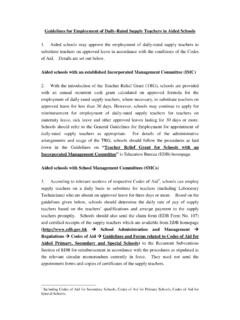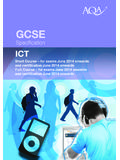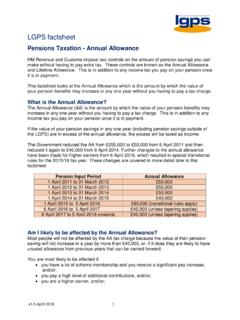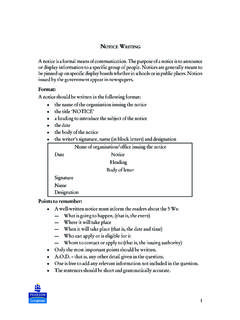Transcription of Driving school minibuses - No D1 licence needed - Minibus …
1 Driving school minibuses Advice for school employers, headteachers and other school staff August 2013 2 Contents Summary 3 Driving a school Minibus 4 What is a Minibus and who can drive one? 4 What is hire and reward? 5 What are social purposes? 5 What are Out of Pocket Expenses? 5 What is On a Voluntary Basis ? 6 Medical standards and renewing a Driving licence 6 Driving under the Section 19 permit scheme 6 Insurance, other requirements and police 7 Frequently Asked Questions 7 Further sources of information 8 3 Summary About this departmental advice 1. This is non-statutory advice jointly produced by the Department for Education (DfE), the Department for Transport (DfT) and the Association of Chief Police Officers (ACPO) on Driving licence entitlement when Driving a school Minibus . It replaces the rel evant section of the DfE health and safety departmental advice.
2 What the law says 2. This advice does not constitute legal advice nor is it a ruling on the law: individual, schools etc should seek independent legal advice on these issues if they have any queries or concerns. The relevant legislation is Part III of the Road Traffic Act 1988 and the Motor Vehicles ( Driving Licences) Regulations 1999 (SI 1999/2864). This is available to view on : Part III of the Road Traffic Act 1988 Motor Vehicles ( Driving Licences) Regulations 1999 (SI 1999/2864)1. Expiry / review date 3. This document will be reviewed if there is a change to the legislation listed above. Who is this advice for? 4. This advice is for school employers including local authorities, governing bodies, academy trusts and proprietors; and head teachers and other school staff. This advice may also be of interest to local authority youth workers and charitable groups working with young people.
3 Key points 5. There are circumstances in which a member of school staff with a car Driving licence (category B) can drive a Minibus . This licence entitlement is set out here and in an interactive flowchart on Schools are also advised to check their insurance and any employer s policies on this matter. 6. There is also an exemption under which drivers can drive minibuses on behalf of non-profit making bodies such as schools using a Section 19 permit. If schools are in any doubt about their legal position they are advised to apply for a Permit. 1 Please note that legislation on these links are not generally consolidated and therefore may not show subsequent amendments. 4 Driving a school Minibus What is a Minibus and who can drive one? 7. A Minibus is a motor vehicle with between 9 and 16 passenger seats2. It is described as a category D1 vehicle by the Driving Vehicle Licencing Authority.
4 8. Drivers who hold a full D1 (or D) PCV entitlement can drive minibuses for hire or reward. 9. There are, however, circumstances when a driver can drive a Minibus within the UK when they hold a car (category B) licence . These circumstances vary depending on when the driver passed their car Driving test. These arrangements only apply when Driving the Minibus in the UK not if Driving abroad. a) If you passed your category B (car) Driving test before 1 January 1997, you can drive a Minibus that is not being used for hire or reward as these licences automatically include category D1 (101) (not for hire or reward) entitlement3. This means school staff with such a licence can drive a Minibus carrying up to 16 passengers with no maximum weight restriction on the vehicle. Drivers with a D1 + E (101) (not for hire or reward) entitlement can tow a trailer over 750kg. b) If you passed your category B Driving test on or after 1 January 1997, you may drive a Minibus that is not being used for hire and reward if the following conditions are met: you are over 21 and have held a category B licence for at least 2 years; the Minibus is used by a non-commercial body4 for social purposes, you receive no payment other than the recovery of your out of pocket expenses ( fuel and parking costs); you provide the service on a voluntary basis; the maximum unladen weight5 of the Minibus is not more than tonnes (or tonnes if including any specialist equipment to carry disabled passengers); and you do not tow a trailer.
5 2 The driver s seat does not count for these purposes. 3 Drivers who have renewed their licence ( when a photo licence is issued) should check that this entitlement has been retained. 4 Maintained schools, Free Schools and academies are considered non-commercial bodies, as are independent schools holding charitable status. 5 The weight of the vehicle (sometimes known as the Maximum Authorised Mass or MAM) is shown on a metal or plastic plate situated in the engine shell or on a door pillar. At least three manufacturers are currently making lightweight Minibus models of tonnes or less which are available in the UK. 5 What is hire and reward? 10. A vehicle which is operated for hire or reward is one where payment is made, in cash or in kind, for the carrying of passengers, or matters which include the carrying of passengers, irrespective of the person to whom the payment is made.
6 This includes direct payments such as a fare or an indirect payment which gives a person an opportunity to travel. It does not matter whether or not the operator is a profit-making entity. A Minibus is used for hire or reward if there is a clear and logical link between payment and the transport provided and that link is not too remote. 11. A Minibus is not being used for hire or reward, for example, where the pupils are not obliged to pay in exchange for the right to be passengers. This applies where independent schools with charitable status, Free Schools and academies use a Minibus not for a passenger service on a commercial basis but to take pupils off-site for trips within the school day or as an extra-curricular activity, where the pupils do not pay for their transport. Independent, fee-paying schools which lack charitable status could be viewed as commercial bodies that operate minibuses for hire or reward; the hire or reward element being school fees.
7 We advise such schools to seek legal advice. 12. If schools (or their insurers) are concerned that they may not meet the definition of not operating for hire or reward they are advised to consider applying for a Section 19 permit (see below). What are social purposes? 13. We consider social purposes to mean non-commercial activities. This includes school trips and travel to sporting fixtures within the school day or as an extra-curricular activity. 14. Where a Minibus is operated to provide passenger services for commercial purposes, the driver must hold a full D1 licence (or a full D licence , which entitles the holder to drive minibuses ). What are Out of Pocket Expenses? 15. Out of Pocket Expenses are remuneration for any fuel costs, parking fees, toll fees or similar expenses incurred as part of a trip. The driver should receive no other payments for Driving the Minibus .
8 6 What is On a Voluntary Basis ? 16. In our view, if the terms and conditions of a teacher s contract of employment state that Driving minibuses is a part of their duties, or if a teacher is paid an additional sum specifically for Driving the Minibus (other than a sum to reimburse the teacher for out of pocket expenses on a cost recovery basis), such staff would be deemed as receiving payment for Driving a Minibus and would not be Driving the Minibus on a voluntary basis . In these cases, a full D1 licence (or a full D licence ) would be needed . 17. However, in our view, if a teacher s contract of employment does not state that Driving minibuses is part of their duties and they receive no additional payment for Driving a Minibus to take pupils on trips or to social sporting events (except for reimbursement for out of pocket expenses), they will be Driving on an extra-contractual, voluntary basis.
9 In this case, the category B licence would suffice (assuming the conditions are met) even if the school reimburses the teacher for fuel, parking and tolls. Medical standards and renewing a Driving licence 18. When your category B Driving licence expires at age 70, the entitlement to drive a Minibus can be renewed upon request, if you meet the medical standards for category D1 drivers. You will need to complete a D2 application form and provide a Medical Examination Report (D4). Further information can be obtained from the DVLA s INF28 leaflet, Driving a Minibus . 19. Every driver must comply with medical standards for any Driving licence issued. Driving under the Section 19 permit scheme 20. A Section 19 permit is usually issued free of charge and is given to non-profit making bodies6 that run transport services which benefit the community. Section 19 Permits are issued to bodies to enable them to provide transport for their own members or other people whom the organisation exists to help.
10 The vehicle must not be used for carriage of members of the general public. It must also not be used with a view to profit, nor incidentally to an activity which is itself carried out with a view to profit. Category B and Category D1 (101) (not for Hire or reward) licence holders are entitled drive minibuses that are operated for hire or reward in accordance with a Section 19 permit. 6 Examples of such non-profit making bodies are bodies concerned with education, religion, social welfare, recreations and other activities that are beneficial to the community. Schools would fall within this classification. 7 Apart from the hire or reward test, the same Driving licence requirements as described in paragraph 9 apply. 21. Permits are available free, or for a small fee, from Traffic Commissioners and designated bodies such as local authorities and various church organisations.






